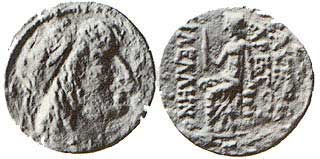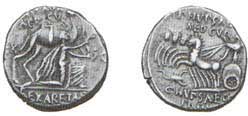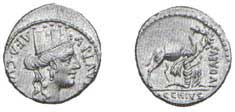Ancient Jewish Coins: The Roman-Judean Coin Connection
(58 - 53 BCE)
The Romans had a long history of interfering with Judaean affairs, as they did with other peoples throughout their sphere of influence. These actions often were reflected on Roman coins. Two such issues were Roman silver denarii that deal with historic events involving Hasmonean kings.
The first denarius was issued in 58 BCE by Marcus Aemilius Scaurus, the governor of the Roman province of Syria. The province included all of the Judaean coast towns from Raphia to Dora, and also all of the non-Jewish towns east of the Jordan River. This distinctive coin commemorates Scaurus’ victory in 65 BCE over the Nabataean King Aretas III. Aretas had allied himself with John Hyrcanus, while the Romans favored Hyrcanus’ brother Aristobulus. The obverse shows the Arabian King Aretas kneeling in submission besides his camel. The Latin inscription reads “REX ARETAS” and gives Scaurus’ title “AED. CVR.” (Curile Aedile - a magistrate regulating trade in the market); “EX S.C.”" indicates that it was issued with the consent of the Roman Senate. The reverses of this and the following coin are general Roman types that don’t have any Judaic connection.
 |
|---|
Nabataean coin of King Aretas III (QEDEM Pl.1, 5)
 |
|---|
Roman Denarius of Scaurus (Herbst 1322)
In 54 BCE, a denarius that was similar in concept to the Rex Aretas coin was issued by the Roman curule aedile Aulus Plautius. The reverse design features a kneeling figure offering an olive branch and holding a camel by the bridle; the enigmatic inscription is “BACCHIVS IVDAEVS” (Bacchius the Jew), whose actual identity is still unknown.
 |
|---|
Roman Denarius of Plautius (Herbst 1323)
Sources: The Handbook of Biblical Numismatics


